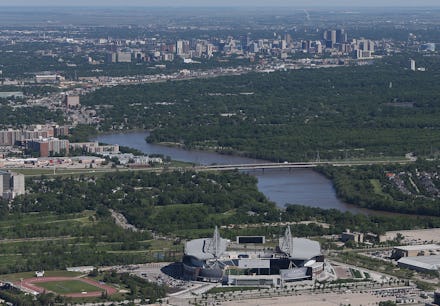Haunting Photos Powerfully Capture the Terror Facing Canada's Indigenous Women Today

A Canadian tragedy: On Aug. 17, Winnipeg police pulled the body of 15-year-old Tina Fontaine out of the Red River near Alexander Docks.
CBC reports she'd been missing for eight days and was found in the water wrapped in a plastic bag.
The month-long investigation into Tina's murder remains unresolved, but with more than 1,200 cases of missing or murdered Aboriginal women and girls reported in Canada over the past 30 years, her fate is far from unique.
1,200. The scope of the tragedy prompted Holly Jarret of Hamilton, Ont. — cousin to Loretta Saunders, an indigenous woman who was murdered in February at age 26 — to launch the #AmINext hashtag earlier this month.
What it is: #AmINext has been used by Aboriginal Canadian women and their allies to demand answers. Many social media users utilizing the hashtag hold signs asking how many more missing and dead women it will take for the government to launch an official inquiry into the crisis. According to CBC, the campaign asks others in solidarity to respond with their own picture within 24 hours, much like the ALS Ice Bucket Challenge.
#AmINext aims to both raise awareness and pressure Prime Minister Stephen Harper's government to take action. Here are some of its more powerful and sobering images:
Scaling the crisis: Though they represent just 4% of the country's population, indigenous women make up 12% of missing and 16% of murdered women nationwide, RCMP Commissioner Bob Paulson told the Globe and Mail.
"Yes, [this number] was a surprise," he said. Previously, studies estimated there had been closer to 824 combined murdered and missing Indigenous women over the past 60 years, not 1,200 in half that time.
So what's being done about it? Not much.
Calls for Harper to launch an official inquiry into the crisis have been met with callousness. Though statistics suggest the blatantly racial nature of the problem, Harper remains keen on ignoring an approach based on what he calls "sociological" factors.
"I think we should not view this as sociological phenomenon," he said in a controversial statement in August, CBC reports. "We should view it as crime. It is crime, against innocent people, and it needs to be addressed as such."
Meanwhile, the tragedy continues: Without speculating as to why Harper thinks crime and sociology are mutually exclusive, the women most victimized by this violence are understandably sick and tired of their government doing so little to solve it. (Some programs have been set up in the interim, despite Harper's views, but with limited success.)
"This crisis has gone on for far too long," MP Niki Ashton said in the House of Commons on Thursday, the Globe and Mail reports. "Families want closure. They want justice. They want to be heard, and they want action from the government."
With the bodies and disappearances piling up by the day, it's past time for Harper's government to consider all factors contributing to the crisis, regardless of his personal views. The Indigenous women of Canada can't afford to wait any longer.
h/t Indian Country Today Media Network